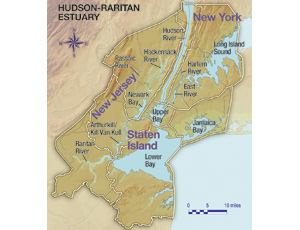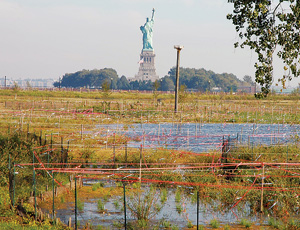The U.S. Army Corps of Engineers and the Port Authority of New York and New Jersey have released a draft plan for the restoration of the Hudson-Raritan Estuary that they hope will lead to a more coordinated effort to remediate the heavily polluted area. Released on April 14, the two-volume Comprehensive Restoration Plan (CRP) provides a framework for restoring the estuary. Corps officials say the plan represents a consensus view of how the estuary—roughly defined as the waters and wetlands within a 25-mile radius of the Statue of Liberty—should be restored. Sources say the plan, the result of a 1999 congressional request, will enable different organizations to work in a more coordinated way. Questions still remain about how the ambitious plan will be funded. It does not set any priorities.
“This is the first time where you had a single document…and an agenda for the region that brings together all of the efforts that have been taking place,” says Lisa Baron, project manager and biologist with the Corps. The list of federal, state and local agencies that participated in developing the plan represents virtually all the entities with an interest in restoring or mitigating the estuary, Baron says.
Among the agencies that provided input are the U.S. Environmental Protection Agency, the U.S. Fish and Wildlife Service, New Jersey Dept. of Environmental Protection, the New York State Dept. of Environmental Conservation, the New York Dept. of State’s Coastal Resource Program and the New York City Mayor’s Office, as well as a number of conservation groups.
Jennifer Curran, project manager for Omaha-based HDR, which had a task order to assist the Corps develop the plan, says that, previously, “There were a lot of different organizations that were conducting restoration projects on their own, and nobody was really communicating.”
The CRP outlines 11 measurable “target ecosystem characteristics” (TEC) that set short- and long-term objectives for restoration. The Coastal Wetlands TEC goal, for instance, is to restore 1,200 acres of wetlands by 2015 and 15,200 acres by 2050, with a price tag of $2.6 billion to $8.6 billion for the short-term goal and $3.3 billion to $10.8 billion for the long-term goal. Overall, the CRP identifies more than 732 projects.
The plan can be used both for conservation efforts and by agencies and developers with mitigation requirements, Curran says. “Anybody who is going to be conducting restoration [of the estuary] now has something to look at,” she says.
Josh Verleun, a staff attorney with Riverkeeper in Tarrytown, N.Y., says, “The fact that there has been a lengthy and comprehensive study is certainly encouraging and…a big step toward fixing the system as a whole,” but implementing change “is always the biggest challenge.” He says state and federal legislation will likely be needed to fully fund projects.
The plan’s advocates acknowledge that securing funding to implement all the targets will be difficult. But having a plan in hand that represents a consensus view of virtually all stakeholders will make it easier to secure federal authorization from Congress, Baron says.
The plan does not estimate total costs for the overall restoration effort but outlines a number of potential sources of funding. The Corps plans to conduct a feasibility study to further evaluate the restoration goals outlined in the CRP, as well as potential costs and priorities. Once complete, the Corps will use that document to obtain federal authorization to move forward with projects.
For now, organizations can move forward with small projects through federal or state grants.
Chris Zeppie, director of the office of environmental policy and compliance for the port authority, says the plan will be a valuable tool for working with local lawmakers and other decisionmakers.






Post a comment to this article
Report Abusive Comment